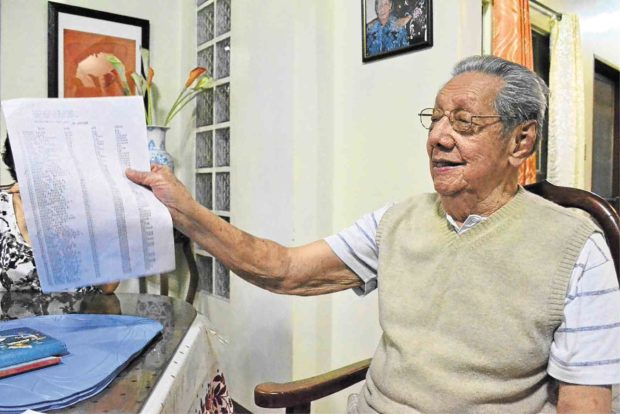‘I did not know death at the time’ – WW2 guerrilla

Private Pablo Santos was just 15 years old when he joined Bruce’s Guerrillas in World War II. —MARIA ADELIDA CALAYAG
BAMBAN, Tarlac — Pablo Santos Jr. was just 15 years old when he joined the Bamban Battalion in the South Tarlac Military District of the Luzon Guerrilla Forces during World War II 75 years ago.
When the Pacific War broke out in 1941 and the Japanese Imperial Army occupied the Philippines in 1942, Santos became a spy of a battalion that soldiers often referred to as Bruce’s Guerrillas.
Santos said he used to steal guns from the Japanese, which the guerrillas used against the invaders, because all they had were bolos.
“I did not fear death [as a teenager]. I did not know death at the time,” said Santos, who at 90 might also be the only surviving member of Bruce’s Guerrillas.
The 208-strong guerrilla unit was named after Captain Alfred Bruce of the United States Armed Forces in the Far East. Bruce hid with Aeta tribesmen, who rescued him after his plane crashed in the Bamban mountains.
Article continues after this advertisementBruce eventually led the battalion, when its former leaders died in battle. The Philippine Veterans Affairs Office said 133 guerrillas were listed in the roster of A Company and 75 operated as B Company of the battalion. The unit had a female guerrilla, Adelaida Villareyes.
Article continues after this advertisementBorn on Dec. 7, 1926, Private Santos of A Company was given serial number 205967 and was immediately dispatched as a courier and an intelligence officer.
Santos said he would greet every Japanese he came across and bow his head low. The war hero said he wanted to appear as “a simple and innocent native,” while he spied on the enemy.
Life was hard, Santos said. Guerrillas and Aetas who hid them survived on sweet potatoes and corn.
Santos said guerrillas operated in Bamban, where the Japanese set up a communications center.
Bamban was also a refueling station for Japanese planes, including the dreaded Kamikaze (suicide pilots). The Central Azucarera de Bamban served as garrison and office of the Japanese Army.
At the end of the war, the Japanese Army hid in tunnels beneath Bamban. The late Bruce’s Guerrillas member Frederico Wage recalled in his journals that the Japanese soldiers refused to leave these caverns during the country’s liberation.
American soldiers tried to flush them out by using flamethrowers. A few Japanese soldiers managed to scamper out of the tunnels to escape the blaze that killed many of their colleagues.
When war ended in 1945, Santos was asked to join the local police force by the late Mayor Sinforoso Lumboy in 1953. Santos was later appointed as the youngest chief of police to serve Bamban. He retired as a police officer in 1986.
Santos, brother of retired Court of Appeals Justice Alicia L. Santos, married Purita Milan. The couple has ten children and 16 grandchildren.